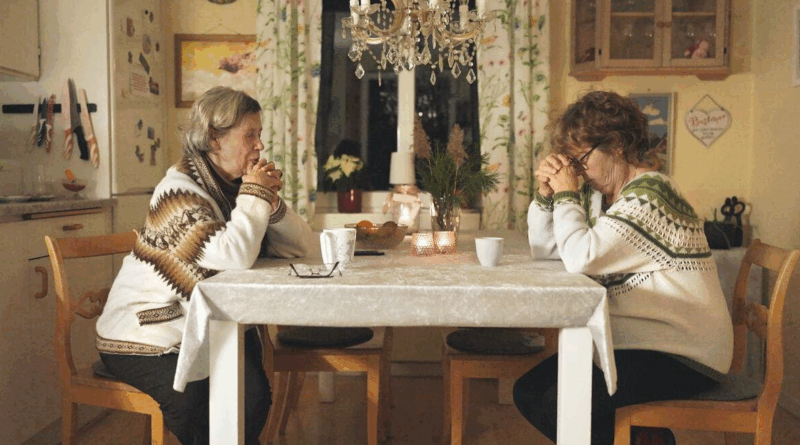INTERVIEW: ‘The Gullspång Miracle’ features a story that defies probability
Photo: The Gullspång Miracle tells the story of sisters Kari and May, and their discovery in a small Swedish town. Photo courtesy of Film Movement / Provided by Foundry Comm with permission.
The Gullspång Miracle, the new documentary from filmmaker Maria Fredriksson, features a story that can be appreciated in a number of ways. There are some viewers who will see the tale as evidence of spiritual intervention, while others will see eerie coincidences at play. Perhaps it’s all of the above, but no matter what happened in Gullspång, Sweden, Fredriksson was there to capture the story and listen to the local residents.
It’s best to experience The Gullspång Miracle without too much prior information, so here’s how Film Movement, which recently premiered the movie on its digital platforms, described the plot: A seemingly divine premonition leads pious Norwegian sisters Kari and May to buy an apartment in the small Swedish town of Gullspång. To their surprise, the seller looks remarkably similar to their older sister Astrid, who was believed to have died by suicide 30 years earlier. What’s even more odd is that this doppelgänger used to go by Lita, the same nickname as their deceased sister.
Fredriksson remembers beginning the documentary project after receiving a phone call from Kari and May.
“Day one was when I got the phone call from the two ladies,” the director said in a recent Zoom interview. “They actually first called the Swedish broadcaster SVT because when this miracle happened to them, people around them said, ‘You should call TV because people need to know about this miracle,’ so they called the TV station. And I made quite a few films about elderly ladies before, so at the documentary department at SVT, they gave the ladies my phone number. So I received a phone call, and I had nothing better to do at the time. I just finished my previous film, and I was waiting for a new project. So I just jumped on the train to Gullspång. I had to look it up on the map because I had never been there before, and, to be honest, I didn’t know where in Sweden it was. It’s a small place. It’s about 1,000 people living there.”
When Fredriksson first heard the details of the story about these sisters, she was amazed and wanted to know more about their family. The description of the third sister, the chance purchase of this apartment in a tucked-away corner of Sweden, the perception that the sisters were receiving signs from paintings — all of the particulars interested the filmmaker.
“I need to meet these women and see what they are like, so I went there and had coffee with them,” she said. “And I thought, OK, this is a great story, but is it possible to make a documentary about it because everything already happened? That’s what I believed at the time. I didn’t expect anything more new to come. It was just a happy family reunion, and they were all trying to be a family. And they were all happy about how they met, so my thoughts at that point was: How can I make a film about it? Can I go back in time and tell about how they were separated? … Of course, I didn’t expect it to be the story it became. I filmed them for about four years.”
Fredriksson is purposely being secretive about the many revelations that are present in The Gullspång Miracle. Those secrets are best left to viewers of the documentary and not spoiled in this written story. For those critics who have reviewed the film, there have been parallels made with the work of David Lynch, especially Twin Peaks, and also the documentary Three Identical Strangers, a film about three identical triplets who were separated at birth. Those references might give a clue of the documentary’s twisty turns.
For Fredriksson, her initial connection to these sisters was because SVT knew she had taken an interest as a filmmaker in telling the lives of women who often are not the focus of stories due to the inherent age discrimination and sexism in the movie business and the world at large. Fredriksson has built a career out of changing that image and giving voice to the voiceless.
“I actually started as a filmmaker because my very first film was about 80-plus ladies who were trying to find new men after becoming widows, so that was my first film,” she said. “Then I made films about 80-plus women’s sex lives because I felt that women of that age, they are never main characters in films. They are a grandmother or interested in knitting or grandchildren or something like that. They are never important, so I made films about elderly women for that reason. But in this film, I’m very happy [because] they are elderly women, but it’s not a film about them being elderly women. It’s a story, and they happen to be elderly women.”
The director added: “I think it’s very much a story about family, and how you relate to your family, and about beliefs, and who you are in a family or in a group, and trying to find your identity. I think it’s very relatable, even though it’s a very unusual story.”
In the documentary, there is discussion of God and divine intervention. The “miracle” part of the film’s title is intentional on Fredriksson’s part, and the director has been delighted that many different viewers have appreciated the story, whether they are believers or not.
“I don’t have to believe what they do, and they also don’t believe the same,” Fredriksson said. “For me, it’s just as important to respect all of them no matter what they believe. For me, it’s always important to try and understand them as people and what they believe. No matter what film I do, I want to understand the people I’m filming. For me, it was very good to hear from Christian people that they think it’s a very good film, and people that are non-religious or not believing that they can also enjoy this film from their perspective. I think one good thing is that when the ladies saw the film for the first time — just before we locked the edit, I had screenings for them — and they said, ‘We love this film, but it’s totally told from our perspective. So maybe [our sister] she will not like it.’ And then I showed it to [their sister], and she said exactly the same thing: ‘It’s told from my perspective, so the others won’t like it.’ So I think that says a lot. You read stuff from your own perspective and who you are, and you can see it from different points of view.”
By John Soltes / Publisher / John@HollywoodSoapbox.com
The Gullspång Miracle, written and directed by Maria Fredriksson, is now available from Film Movement. Click here for more information.

